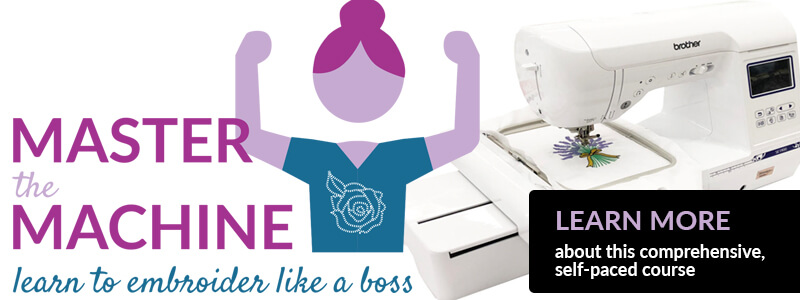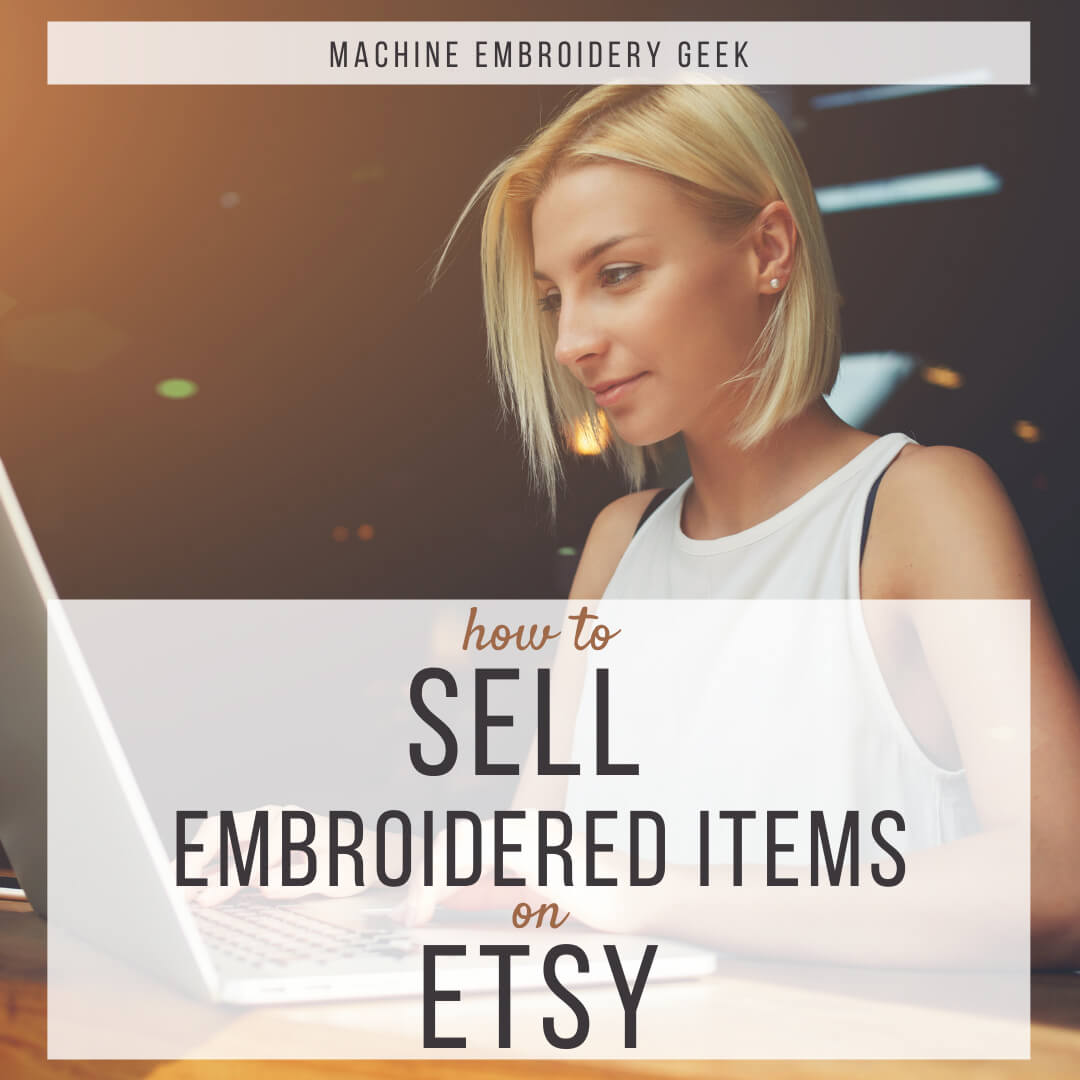How to set up an e-commerce website for your embroidery business
This site contains affiliate links to products. We may receive a commission for purchases made through these links.

Are you an embroiderer with a burgeoning business? Are you looking for new ways to sell your products? If so, then you need to start selling embroidered items from your website! Sound like too much work? Or too technical. Or not worth your time? It’s actually not. In this article, I’ll walk you through the steps necessary to set up an e-commerce website for your embroidery business. I’ll also explain some of the benefits of selling online through your own website (as opposed to selling your embroidered items though platforms like Etsy).
Building websites is a topic near and dear to my heart as I’ve been building websites since the mid 1990s. A lot has changed over the years. But the good news is that it’s gotten much much easier to build an e-commerce website than it used to be. It’s also gotten a lot cheaper.
Allow me to explain…
Products mentioned in this post
Benefits of setting up an e-commerce website for your embroidery business
There are several reasons why you would want to set up an e-commerce website for your embroidery business.
Unless you have been living under a rock for the past 25 years, you are likely well aware of the fact that websites allow you to reach a larger audience than you would be able to reach through traditional methods such as brick-and-mortar stores or word-of-mouth. By selling online, you can sell your products to customers all over the world! Boom! You get a much larger customer base.
Another benefit of setting up a website for your embroidery business is that it allows you to track your sales and traffic data. This information can help you make better business decisions in the future. For example, if you notice that a certain product is selling better than others, you can make more of those items in the future.
Why sell your embroidered products through your own e-commerce website?
I realized that you can get many of the aforementioned benefits just by setting up a store via Etsy. However, having your own website from which you sell your products gives you a distinct advantage. Here’s what I mean.
You can have your own URL
Platforms like Etsy do not allow you to have your own unique URL. The URL of your Etsy store is yourbusinessname.etsy.com. By having your own website, you can choose whatever domain name you like and make it easy for customers to remember you and find you online.
Having your own domain name and your own standalone website also gives you some authority. Anyone can set up an Etsy store, but it looks more professional and credible if you have your own website.
You can control the look, feel, and content of your website
When you set up a store on Etsy or any other platform, you are limited in terms of the design and functionality of your store. You must use the template that is provided to you, and you are not able to change the look and feel of your store very much. With your own website, on the other hand, you can control every aspect of the design. You can choose a theme that matches your brand and style, and you can customize it to fit your needs.
You can build your own customer list
When you sell on Etsy or another platform, the customer list belongs to the platform. If you ever want to move your store to another platform or stop using the platform altogether, you will not be able to take your customer list with you.
If you have your own website, however, you can build your own customer list that belongs to you. This is a valuable asset that you can use to market to your customers in the future.
You don’t have to give away a portion of your sales
When you sell on Etsy or another platform, you are required to pay a commission on each sale. This commission can be as high as 20% of the sale price. By having your own website, you can avoid paying these commissions and keep more of your profits for yourself!
Challenges associated with setting up an e-commerce website for your embroidery business
Of course, there are some challenges associated with selling through your own website.
Traffic
The first challenge is that you will need to drive traffic to your website. You can do this through various marketing and advertising channels such as social media, Google AdWords, or even good old-fashioned word-of-mouth.
Sites like Etsy have provide built-in traffic. People go to Etsy to shop. Etsy also runs ads for their seller’s products.
Payment systems
Another challenge is that you will need to set up a payment system on your website. This can be done through PayPal or by setting up a merchant account with a company such as Stripe. While this may sound a bit complicated, it’s actually not bad. You just need to establish accounts with these companies and then it’s just a matter of copying and pasting relevant data into the dashboard of your site.
Taxes
Unlike when you sell on Etsy, you will be responsible for collecting and paying taxes on the sales of your products through your own website. In the United States, you will need to collect state sales tax as well as federal taxes.
You will also need to file quarterly tax returns and pay estimated taxes throughout the year. This can be a bit of a challenge if you are not used to dealing with taxes, but there are many resources available to help you.
Shipping
The last challenge is that you will need to ship your products to your customers. This requires you to package and label your products correctly and then drop them off at the post office. It’s a lot easier on Etsy as they provide shipping labels right from their site.
Availability
One of the nice features of Etsy is that you can put your store on “vacation mode,” when you go out of town to let shoppers know that you will not be shipping items for the time being.
Of course, you can do this as well on your own website. it’s just not quite as simple.
While there are some challenges associated with selling through your own website, I believe that the benefits outweigh the challenges. If you are serious about selling embroidered products, I recommend that you set up your own website as soon as possible.
How to set up an e-commerce website for your embroidery business
I have been building websites since 1996, and let me tell you, we have come a LONG way. In the early days, selling products on the Web required coding know-how and wasn’t cheap to do. Nowadays, there are several different platforms that allow you to build your own e-commerce store.
Registering a domain name
But, before you start building your online store, you need to register a domain name. This is the name of your website (e.g., myembroiderystore.com). You can do this through a domain name registrar such as GoDaddy or NameCheap. It doesn’t matter where you register the domain name, the ownership of the domain name is recorded in a networked database called the domain name system that all domain registrants have access to.
Keep in mind that when you register a domain name, you are actually just renting the name. You will need to renew the domain name each year. Don’t worry, your registrant will send you a reminder when it’s time to renew. The cost to own a domain name is usually about $15/year.
I recommend that you buy a “.com” domain name, as it is the most popular domain extension. It also implies “commerce,” so it is appropriate for a website that is selling goods.
Hosting
Once you register a domain then you need to point it to your website. While this may sound a bit technical – it’s not too difficult. The company that you use for hosting will provide the information you need to point your domain name to your new site.
Therefore, your next task is to figure out where you want your website to “live” on the Internet. And, actually, you may want to decide this first, as many of these hosting companies are also registrants. When you purchase a domain name through your hosting company, it’s a bit easier to point your domain name to your website.
If you were building a website purely from code, then all you would need is some barebones hosting space on a web server. But, I doubt that’s the route you want to take being that many companies provide hosting as well as a built-in tool for making an e-commerce site.
Let’s take a look at the most common e-commerce platform, i.e. hosting environments that have built-in tools that allow you to set up an e-commerce website for your embroidery business.
E-commerce platforms
Before you commit to any of the following platforms, you should take some time to research each one and decide which one is the best fit for you. Below, I have listed a few of the most popular e-commerce platforms. All of them are great options for setting up an e-commerce website for your embroidery business.
Shopify
Shopify is a very popular e-commerce platform known for being user-friendly, especially if you are not a technical person. The company takes care of all the hosting and security for you so that you can focus on building your business.
You can also point your own domain to your Shopify store. When you set up a Shopify store, you are given a default domain name (yourstore.myshopify.com) but you can also point your own domain name right to your Shopify store. In fact, you can actually register a domain right on the Shopify site.
Shopify was made for e-commerce. So, if the focus of your site is first and foremost – shopping – it’s a great choice.
The downside to Shopify is that it can be a bit pricey, starting at $29/month (and going up to $179/month). This does not include the cost of your domain name.
Wix
Wix is another popular website builder that also allows you to set up an e-commerce store. Like Shopify, Wix takes care of all the hosting and security for you.
One thing to note about Wix is that it does not allow you to use your own domain name (unless you upgrade to a premium account). You are given a subdomain, e.g. mystore.wixsite.com/mysite, as part of your account.
Wix is free to use with a few limitations (e.g., you can only have one product for sale). If you want to remove these limitations, it will cost you $11/month for the premium account.
Weebly
Weebly is very similar to Wix in that it is a website builder with e-commerce capabilities. Unlike Shopify, the website content is the emphasis and not necessarily the e-commerce capabilities. That came later.
Just like on Shopify or Wix, on Weebly, you can use your own domain name or you can use Weebly’s subdomain (e.g. mystore.weebly.com/mysite).
One thing to note about Weebly is that it is not as user-friendly as Shopify or Wix. It can be a bit more challenging to use, especially if you are not technical.
Weebly has a free plan with some limitations (e.g., you can only have 20 products for sale). If you want to remove these limitations, the premium account will cost you $12/month.
BigCommerce
BigCommerce is a bit more technical than Shopify or Wix but it is still relatively user-friendly. And it’s equipped to handle a pretty substantial e-commerce store.
The company takes care of all the hosting and security for you. You can use your own domain name or you can use BigCommerce’s subdomain (e.g. mystore.bigcommerce.com/mysite).
BigCommerce has a free plan with some limitations (e.g., you can only have two products for sale). If you want to remove these limitations, the premium account will cost you $29.95/month.
SquareSpace
SquareSpace is not specifically an e-commerce platform but it does allow you to set up an online store. If an elegant look is a high priority, you may want to consider it as SquareSpace is known for their beautiful templates.
You can use your own domain name or you can use SquareSpace’s subdomain (e.g. mystore.squarespace.com/mysite).
One thing to note about SquareSpace is that it is not as user-friendly as Shopify or Wix. It can be a bit more challenging to use, especially if you are not technical.
The cost of SquareSpace starts at $12/month (but goes up to $40/month for the online store).
WordPress
WordPress is a bit trickier to explain because you can build a WordPress site in two different ways. You can either set up a site on WordPress.com or you can purchase hosting from just about anyone and install WordPress in that hosting environment (which is called self-hosting). If you plan to build a WordPress site with e-commerce capabilities, a self-hosted WordPress install is the way to go as it is the least expensive and give you the most control.
Almost every hosting provider allows you to install WordPress. And, they make it very easy for you to do so. Even very inexpensive hosting plans support WordPress. For example, you can purchase a $2.95/month hosting plan on Bluehost and install WordPress into your hosting space.
Once you have installed WordPress, you will need to install a plugin called Woocommerce in order to create an e-commerce store. Woocommerce is free to use.
So, although it requires a few extra steps to set up and customize, a WordPress / WooCommerce store is by far the cheapest way to set up a website for your embroidery business. In fact, that’s exactly what I use.
Ready to set up an e-commerce website for your embroidery business?
Now that you know a bit more about some of the most popular e-commerce platforms, you can decide which one is right for you and get started setting up your e-commerce website for your embroidery business.
Good luck!
X0-
Julie
Want to remember this? Save “How to set up an e-commerce website for your embroidery business” on your favorite Pinterest board



















